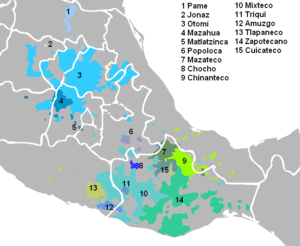Mazahua language
| Mazahua | |
|---|---|
| Jñatjo | |
| Region | Mexico: State of Mexico, Toluca |
| Ethnicity | Mazahua |
Native speakers | 140,000 (2010 census)[1] |
|
Oto-Manguean
| |
| Official status | |
| Regulated by | Secretaría de Educación Pública |
| Language codes | |
| ISO 639-3 |
Either: mmc – Toluca Mazahua maz – Central Mazahua |
| Glottolog |
maza1293[2] |
|
The Mazahua language, number 4 (darker blue), northwest. | |
The Mazahua language is an indigenous language of Mexico, spoken in the country's central states by the ethnic group widely known as the Mazahua but who refer to themselves as Hñatho. Mazahua is a Mesoamerican language and shows many of the traits which define the Mesoamerican Linguistic Area. Along with some 62 other indigenous languages, it is recognised by a statutory law of Mexico[3] as an official language in the Federal District and the other administrative divisions in which it is spoken, and on an equal footing with Spanish. The largest concentration of Mazahua is found in the municipality of San Felipe del Progreso, State of México, near Toluca.
The closest relatives of the Mazahua language are the Otomi, Matlatzinca and Ocuilteco/Tlahuica languages, which together with Mazahua form the Otomian subgroup of the Oto-Pamean branch of the Oto-Manguean language family.
Mazahua is a tonal language and distinguishes high, low, and falling tones on all syllables except the final syllable of a word, on which the word stress falls predictably.
Mazahua's most distinctive feature is its abnormally large phoneme inventory, which totals around sixty phonemes, or twice the number in English. There are eight vowel phonemes, seven contrastive nasal vowels, and as many as forty-five consonants.
Amongst these are ejectives, implosives and contrastive voiceless sonorants. Along with Sindhi and Tukang Besi, Mazahua is a rare case of a language with true implosives far isolated from regions where implosives are commonly encountered. It is also one of the few languages with ejective fricatives.[4]
Mazahua-language programming is carried by the CDI's radio station XETUMI-AM, broadcasting from Tuxpan, Michoacán.
Sounds
Consonants
| Bilabial | Alveolar | Palatal | Velar | Glottal | |||
|---|---|---|---|---|---|---|---|
| plain | lab. | ||||||
| Nasal | glott. | m̰ | n̰ | ɲ̰ | |||
| voiceless | m̥ | n̥ | ɲ̥ | ||||
| plain | m | n | ɲ | ||||
| Plosive | implosive | ɓ | ɗ | ||||
| ejective | tʼ | kʼ | kʼʷ | ||||
| aspirated | pʰ | tʰ | kʰ | kʷʰ | |||
| tenuis | p | t | k | kʷ | ʔ | ||
| voiced | ɡ | ɡʷ | |||||
| Affricate | ejective | tsʼ | tʃʼ | ||||
| aspirated | tsʰ | tʃʰ | |||||
| tenuis | ts | tʃ | |||||
| Fricative | ejective | sʼ | |||||
| aspirated | sʰ | ||||||
| tenuis | s | ʃ | h | ||||
| voiced | z | ʒ | |||||
| Approximant | glott. | j̰ | w̰ | ||||
| voiceless | j̊ | w̥ | |||||
| plain | l | j | w | ||||
| Trill | r | ||||||
Oral vowels
| Front | Back | |
|---|---|---|
| Close | i | u |
| Close-mid | e | o |
| Mid | ə | |
| Open-mid | ɛ | ɔ |
| Open | a | |
Nasal vowels
| Front | Back | |
|---|---|---|
| Close | ĩ | i |
| Close-mid | ẽ | õ |
| Open-mid | ɛ̃ | ɔ̃ |
| Open | ã | |
Notes
- ↑ INALI (2012) México: Lenguas indígenas nacionales
- ↑ Hammarström, Harald; Forkel, Robert; Haspelmath, Martin; Bank, Sebastian, eds. (2016). "Mazahua". Glottolog 2.7. Jena: Max Planck Institute for the Science of Human History.
- ↑ The Ley General de Derechos Lingüísticos de los Pueblos Indígenas ("General Law of the Linguistic Rights of Indigenous peoples"), decree published 13 March 2003
- ↑ Ian Maddieson (with a chapter contributed by Sandra Ferrari Disner); Patterns of sounds; Cambridge University Press, 1984. ISBN 0-521-26536-3
References
- Knapp Ring, Michael Herbert, Fonología del mazahua, Tesis de licenciatura, ENAH, México, 1996
- Michael Knapp, 2002 “Elementos de dialectología Mazahua" In Del Cora Al Maya Yucateco: Estudios Linguisticos Sobre Algunas Lenguas Indigenas Mexicanas Paulette Levy (Ed.), Universidad Nacional Autonoma De Mexico
| Mazahua language test of Wikipedia at Wikimedia Incubator |
